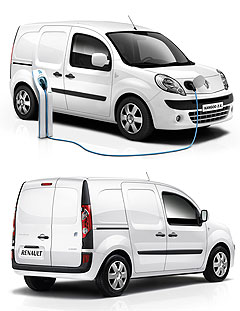Future models - Nissan - NV200Nissan’s electric van nearsLoad carrier: Nissan's NV200 will arrive in Australia next year, and be followed by an electric workhorse. All-electric Nissan e-LCV delivery van nears, but it won’t be for everyone22 Jun 2010 NOT content with releasing what it says will be the world’s first mass-production electric vehicle (EV) here in 2012, Nissan has committed to launching an all-electric delivery van alongside the zero-emissions Leaf hatchback in Australia, but admits it will not be for everyone. The Japanese car-maker has confirmed the ‘e-LCV’ will be one of four EVs it will release globally from this year, starting with the Leaf five-door in Japan and five US states and also including a compact four-seat Infiniti sportscar and a production version of the wacky two-seater LandGlider concept. Nissan’s alliance partner Renault will also produce four EVs, led by the stylish Fluence ZE sedan and Kangoo ZE van, both of which are already on sale in Europe before first deliveries take place in 2011. Renault’s new (conventional-engined) Kangoo is earmarked for release here within months, while the Fluence is also expected on sale here with an internal combustion engine by late 2010. Before the Leaf goes on sale here in about two years’ time, however, Nissan hopes to release its first delivery van in Australia for almost two decades. Nissan Australia’s first commercial van will be a version of the new Volkswagen Caddy-sized NV200, which made its world debut at last year’s Geneva motor show and will be followed by a larger commercial van that will directly rival the likes of Toyota’s top-selling HiAce, as well as Hyundai’s popular iLoad and the VW Transporter.  Left: Renault Kangoo ZE. Left: Renault Kangoo ZE.Nissan has indicated the NV200 will be released in Australia with conventional engines as early as next year, before being joined by a zero-emissions version which will be a direct rival for the Ford’s forthcoming Transit Connect EV in the US. “For a start we’re looking at a small van,” Nissan Motor Co Australia CEO Dan Thompson said at last week’s pre-production Leaf drive in Japan. “We don’t currently have a van in the (Australian) market, so our first port of call is to launch the LCV or, let’s say, van part of our business before we move into e-LCV. “It depends on what you call conventional, but we’ll launch a small conventionally powered van first, then following that we’ll look at e-LCV.” Like the Kangoo ZE, the e-LCV is expected to use a variation of the Leaf’s pioneering electric drivetrain. Instead of being powered by an 80kW/280Nm electric motor as seen in the Leaf, however, it’s likely to employ the Kangoo ZE’s lower-output 44kW/226Nm motor. Although both vehicles’ lithium-ion battery packs weigh about 250kg, the 1410kg Kangoo ZE will be significantly lighter than the circa-1600kg Leaf. In turn, the Fluence ZE is somewhere in the middle in terms of both weight and power, at 1543kg and 70kW/226Nm. However, like the Leaf and Fluence, both battery-electric commercial vehicles will have a maximum driving range of about 160km, before requiring about seven hours to fully recharge via a 240-volt power outlet. Mr Thompson conceded that long-distance e-LCV drivers would require 400-volt depot-based quick-charging infrastructure, which can replete the vehicle’s battery to 80 per cent capacity in less than half an hour. “We’d be looking at a quick-charge solution,” he said. “So if you have a fleet driver or courier doing those types of kilometres on a given day, in most cases the routes are all planned, so it’s a matter of ensuring that in terms of infrastructure there’s always a home base for quick-charging. “Quick-charging infrastructure would be necessary for fleets doing that type of usage in a given day. We say a quick-charge takes 26 minutes – presume it’s half an hour – so that could happen while they’re reloading the van.” So far only a handful of quick-charge EV stations are up and running in Australia but, as in Japan and the US, Nissan dealers expected to install them around the nation. Unlike the ZE-branded Renaults, however, Nissan’s EVs will not initially be compatible with the battery-swap system proposed by EV infrastructure provider Better Place, which plans to begin its Australian recharging network in Canberra from 2012. Nissan Motor Co chief operating officer Toshiyuki Shiga told GoAuto at last week’s world-first Leaf drive that using cheaper off-peak power for delivery work during the day would be one of the key advantages of the e-LCV, but admitted it won’t be a substitute for all users of traditional vans. “One of the advantages of e-LCV is that electricity costs much less at night,” he said. “I don’t know about Australia but in Japan power costs about half at night, so they are charging at night and using the power during the day. “Maybe high-mileage transportation is not appropriate for the e-LCV, but for sales people visiting hospitals and those types of businesses it is well suited,” said Mr Shiga.  Read more15th of June 2010  Nissan amps up calls for EV subsidiesAustralian Nissan chief says lack of local subsidies will hurt EV roll out15th of June 2010  Nissan gets vocal with electric LeafWorld-first audible pedestrian warning to come standard with Nissan’s Leaf EV |
Click to shareNissan modelsResearch Nissan Motor industry news |
















Facebook Twitter Instagram